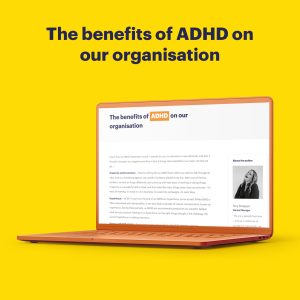This is written by me, Tory Simpson, an ADHD-leader of our marketing agency. It’s not a reflection of ResourceiT, but my advice and thoughts on what businesses need to do to get the most out of their staff. It’s not exhaustive, I’m open to more ideas, research, discussion and thoughts!
Let’s start making everyone’s workplaces better by opening up this topic.
We’ve talked about, in my last blog, all of the wonderful things ADHD-ers bring to a business, from creativity and flexibility to empathy and enthusiasm. But what does a company need to do to enable the ADHD-er to be their best selves?
Flexibility – Proper, actual, real flexibility. I will not miss a deadline, the work I produce will be incredible, and I will over-achieve – IF you give me the space to do so. I talked in my first blog about being ‘in the mood’ – I can only do something properly when I’m in the mood to do so. Give me the flexibility to do what I need to do when I need to do it, and you’ll reap the rewards.
Sometimes this looks like 9-5:30 in the office, sometimes this looks like 6-11pm. Sometimes this looks like a 20 hour work week, followed by a 70 hour one. When we’re talking about flexibility here, it’s not about the choice between WFH or Office, it’s to manage my own workload and time, as and when I need to.
How do you do this, as a business? Whilst you can’t just say to all of your staff – “work whenever you want”, what you can do is give them the flexibility to make their own choices and the flexibility to adapt to your teams needs. If you’ve got ADHD-ers, talk to them 1:1. Give them your trust, and let them own it. Know they can take space when they need it, and work late / early when they want to. This is without a doubt the biggest thing a company can do to support an ADHD individual.
Support and recognition – Sometimes we get really overwhelmed. I’ve developed a bit of an individual groove with all my neuro-diverse reports but this roughly looks like;
- Safe space to offload – sometimes we just really need to offload. Having ADHD means spinning a million things around in your head at any one moment. Talking that through can really help
- To-do lists – often, after the offload, a to-do list is needed. I often do that together with the person I’m working with, what have you got on, what’s urgent and important, what can someone else do, what can not be done, what’s not important at all. Working with their manager on what is needed and expected vs what is too much resets expectation and relinquishes the ADHDer of brain-spinning.
- Recognition – as an ADHDer myself, I speak from experience when I say we give ourselves a really hard time. Sometimes, once the ‘offload’ has happened, we just need someone to pull out all the highlights of what we have achieved, and how well we’re doing – and tell us to take a second to appreciate that. A good (but genuine) pat on the back really helps!
Change – In my experience, ADHD thrives on change. BUT only where the ADHD person accepts it. Don’t suddenly move their desk, or change their laptop – but get them involved in a new project, or a new client, get them working with a new team. Working on something new and shiny is always a win, just balance this with when the person has the capacity, or I like to refer to it as ‘brain-space’ to take this on!
Creativity – In my first (and second actually!) blog in this series, I mentioned ADHD and creativity. It’s the perfect pairing. Get your neurodiverse in a creative space. How do you do this? Well, creativity can look like so many things, not just what we picture when we think of creativity in artists and music and pictures. But, a new way of working, a challenge that needs solving, all roles in a business can be helped by creativity – let this happen and encourage it!
Authenticity – Teach leaders in your organisation about authentic leadership – this helps if you’re an ADHD leader, or an ADHD employee. Building a relationship based on trust, respect and playing to strengths fosters the best working environment. An ADHD person often latches onto someone they can trust. They thrive by being able to have productive, helpful discussions and in order to do that they need to be able to open up, and trust that their leader will catch them.
Regular check-ins – As a person with ADHD, I HATE a monthly 1:1. It goes against the way I work. I’m not saying scrap the process, but adjust it. Sometimes I’ve absolutely nothing to say, sometimes I have a million things. With ADHD, I find something is REALLY important but then I stew on it for a few weeks (literally!) and it’s no longer an issue. That monthly 1:1 doesn’t work for me. I’ve stored something up and have loads of problems, or I’ve got nothing on the list and you won’t have a productive meeting. This is quite a common theme with the neurodiverse I know and work with, but how do you solve it as a business? Regularly check in with your ADHDer – and be flexible with what they need. This might mean you need to clear your afternoon to help them, but remember everything they bring to you, and give it back to them by knowing they can do that. A quick message in the morning or a quick call is a good way to build this in. And set an agenda for 1:1 meetings. If they need to prepare for it, they can and will – and give them the opportunity to cancel that 1:1 without any repercussions.
This is what I’ve found to be most effective for getting the most out of my neurodiverse employees, and for those employees to love work, feel valued and enjoy what they do! It’s about trusted relationships, growth and playing to everyone’s strengths. There’s loads of adaptations businesses can make in tools and technology – which some can be funded by the UK Government, but honestly – I find managing ADHD myself, and my ADHD teams, it’s the softer stuff that makes the difference. It’s support, flexibility and care that get’s us through. <3







